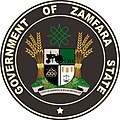This article needs additional citations for verification .(July 2025) |
| Coat of arms of Nigeria | |
|---|---|
 | |
| Versions | |
 Version used from 1960 to 1979 | |
| Armiger | Federal Republic of Nigeria |
| Adopted | 20 May 1960 |
| Crest | An eagle displayed Gules. |
| Torse | Argent and Vert |
| Shield | Sable a Pall wavy argent |
| Supporters | Two horses Argent |
| Compartment | A grassy field proper, the yellow flowers at the base (incorrectly shown as red in the image) are Costus Spectabilis, Nigeria's national flower. |
| Motto | Unity and Faith, Peace and Progress |
The coat of arms of Nigeria consists of a black shield with a wavy white pall, symbolising the meeting of the Niger and Benue Rivers at Lokoja. The black shield represents Nigeria's fertile soil, while the two supporting horses or chargers on each side represent dignity. The eagle represents strength, while the green and white twists of the torse on the top of the shield represent the colours of the Nigerian Flag. [1]
Contents
The red flowers at the base are Costus spectabilis , Nigeria's national flower. This flower was chosen for inclusion in the coat of arms as it is found all over Nigeria and also stand for the beauty of the nation. On the banderole around the base is Nigeria's national motto since 1978: "Unity and Faith, Peace and Progress" (formerly "Peace, Unity, Freedom"). [1]


































